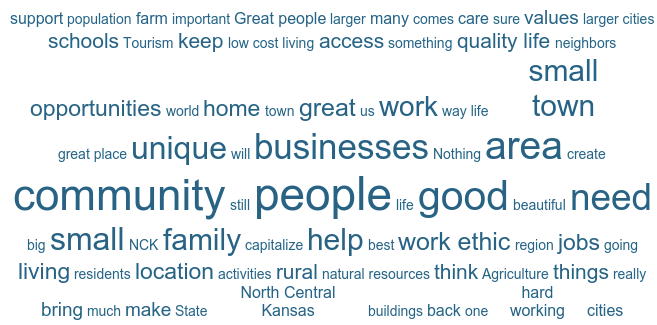A multi-year strategic planning process that included collaboration among partners and stakeholders has resulted in the completion of the most recent strategic plan for the region.
The plan is formally known as the Comprehensive Economic Development Strategy, or CEDS for short. A CEDS is updated every five years and is also a prerequisite for Federal designation as an Economic Development District. The NCRPC Economic Development District includes 12 counties in North Central Kansas and 83 member cities.
A 2018 CEDS survey of individuals who live or work in the region indicate there are many positive and unique attributes in North Central Kansas on which to build. The “word cloud” image below represents responses to the following question: What makes North Central Kansas unique? More survey results are included in the 2019 CEDS.

Through the planning process, NCRPC identified five main visions critical to the success of North Central Kansas:
- Regional Collaboration
- Economic Prosperity through Innovation
- Superior Physical Assets
- Passionate Leadership from Empowered Citizens
- Exceptional Quality of Place
The NCRPC appreciates the many partners — cities, counties, nonprofit organizations, banks, businesses, educators, current and past board members, and all leaders and citizens — who participated in this process to plan and strategize for a stronger North Central Kansas.
To learn more or to view the latest CEDS, visit www.ncrpc.org/about/abouttheregion/ceds/.
This article appeared in the March 2019 NCRPC Newsletter.

 Two high school seniors in North Central Kansas are being recognized with the John R. Cyr Rural Voices Award for submitting the top entries in the 2018-2019 Rural Voices Youth Contest.
Two high school seniors in North Central Kansas are being recognized with the John R. Cyr Rural Voices Award for submitting the top entries in the 2018-2019 Rural Voices Youth Contest. The Community Development Block Grant (CDBG) program requires that each CDBG funded activity must either benefit low- and moderate-income (LMI) persons (at least 51% LMI), prevent or eliminate slums or blight, or resolve an urgent need where local resources are not available to do so.
The Community Development Block Grant (CDBG) program requires that each CDBG funded activity must either benefit low- and moderate-income (LMI) persons (at least 51% LMI), prevent or eliminate slums or blight, or resolve an urgent need where local resources are not available to do so. Helping make home ownership more affordable was one goal of the NCK Home Ownership Pilot Program that assisted home buyers this past year in Cloud and Mitchell counties.
Helping make home ownership more affordable was one goal of the NCK Home Ownership Pilot Program that assisted home buyers this past year in Cloud and Mitchell counties.